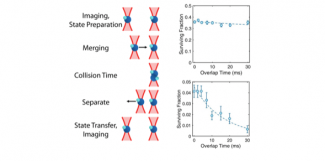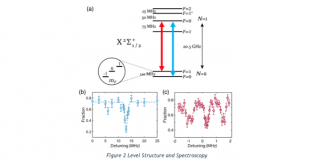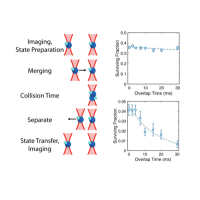News
Controlled Collisions of Exactly two Ultracold Molecules
One of the fundamental questions in the study of ultracold polar molecules is “what happens when two molecules collide at ultracold temperatures?” Knowing whether the molecules undergo chemical reactions, form long lived complexes, change internal state, or bounce off each other carries important implications which will guide future research directions. Our recent experiment explores this question using optical tweezers to collide exactly two ultracold CaF molecules, shedding light on the collisional processes that lead to molecule loss from optical traps.
Optical tweezers are microscopic traps containing at most one molecule, which can be detected with high fidelity by direct imaging. In the collision experiment, two optical tweezers, each containing one molecule prepared in a desired quantum state, are merged together into a single tweezer trap. The two molecules in the single tweezer can collide with each other for the duration of the tweezer overlap time. After the overlap, the tweezers separate and an image is taken to count the surviving pairs of molecules. From the lifetime measurements of the colliding molecule pairs and measurements of trap properties, the two-body loss rates are calculated.

Figure 1 Merging scheme
The first step is to take an image to identify the loaded tweezers. Next, optical pumping and microwaves are used to prepare a desired state. Then one tweezer is moved on top of the other tweezer and switched off. The two molecules coexist in the same trap and undergo collisions for the overlap time, after which the tweezers separate, and the surviving molecules are imaged. When a single molecule is loaded, the experiment proceeds unchanged. The top right figure shows that the survival of a single molecule is independent of the overlap time, validating that the measured two-particle loss is truly a two-particle effect. The bottom right plot shows the survival of pairs of molecules.
As an added level of control beyond what the tweezers provide, microwaves are used to prepare the molecule in a single internal quantum state prior to the collisions. State-controlled collisions can help isolate some possible loss mechanisms. In the experiment, loss rates were measured for rotationally excited molecules, molecules in excited hyperfine states, molecules in the absolute ground state, and molecules in magnetic spin-polarized states. All of these states mentioned above had nearly the same measured loss rate, strongly suggesting that rotational and hyperfine relaxation are not dominant loss processes. While CaF+CaF is known to react without an activation barrier, the spin polarized state should have a large barrier. Collision data taken at low magnetic fields does not indicate any reduction in loss rate, possibly suggesting that spin-polarization is not preserved during the collision.

Figure 2 Level Structure and Spectroscopy
Panel (a) shows the level structure of the ground (N=0) and N=1 excited rotational states of CaF. Optical pumping is used to populate the N=1, F=0 state, then a microwave pulse or sweep can couple population to the N=0 hyperfine states. Panel (b) shows microwave spectroscopy of the transition to the absolute ground state. Panel (c) shows the three mf projections of the N=0,F=1 state resolved in a small magnetic field.
The data indicate that none of the states investigated in the study will naturally produce a low collisional loss rate. Similar findings in bi-alkali molecular samples suggest that “engineering” a repulsive shield is necessary to stabilize high density samples of molecules against collisional loss. To this end, we are now working to implement one scheme which uses microwaves to activate strong repulsive interactions for all orientations of colliding molecules. The strong repulsive interactions cause the molecules to bounce off each other without coming to short range where chemical reactions can happen. Implementing microwave shielding does not come without technical challenges, as high-power and high-circular polarization purity microwaves are required. High microwave power ensures that the molecules remain in quantum states that repel each other during a collision, while high circular polarization purity is needed to plug a hole in the shield that exists for linearly polarized microwaves.
Successful implementation of a shielding scheme for ultracold dipolar molecules will enable the realization of high phase space density bulk gas samples with reduced loss rates. A stable molecular bulk gas would serve as the starting point for a rich research agenda of physics involving strongly interacting anisotropic ultracold quantum gases.
